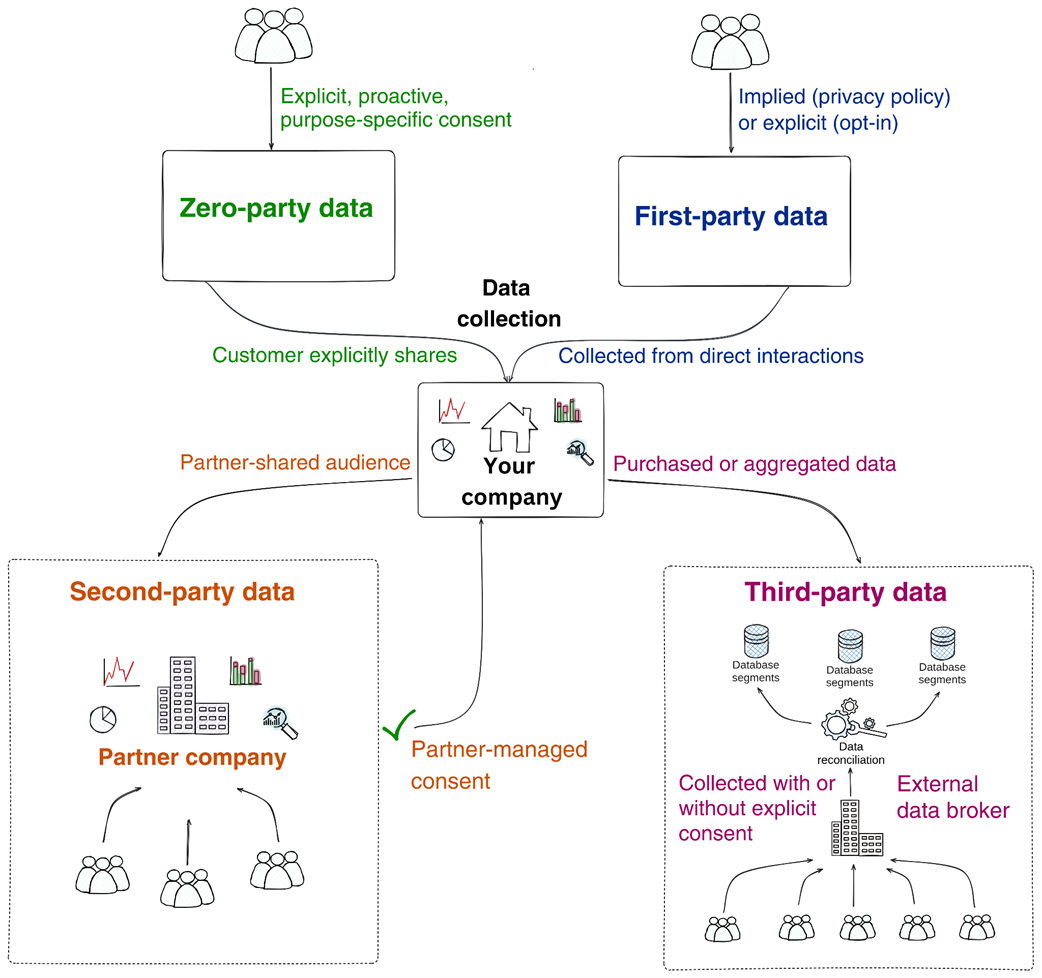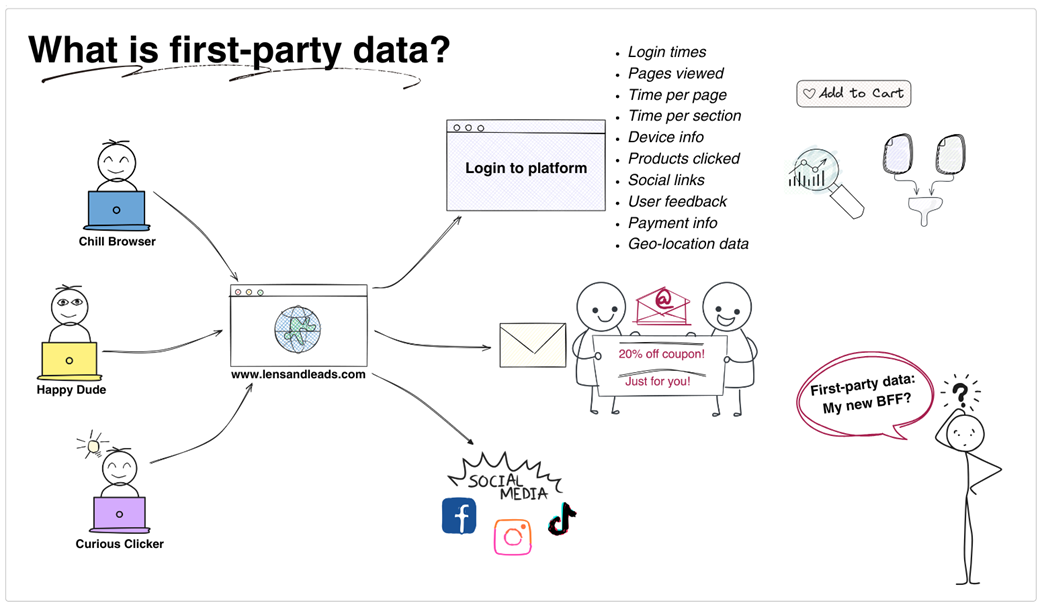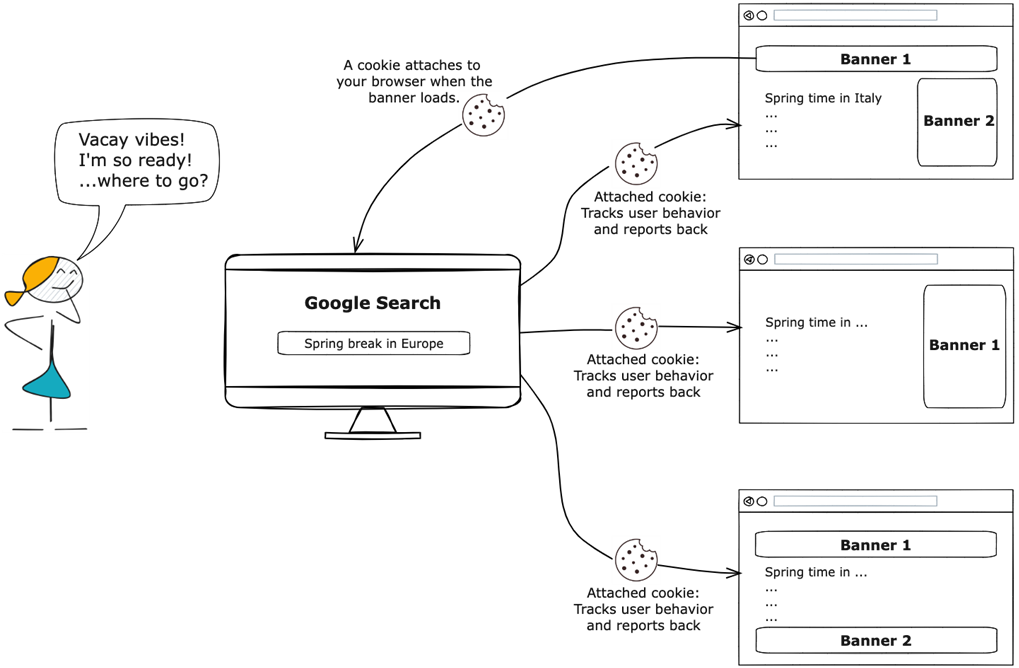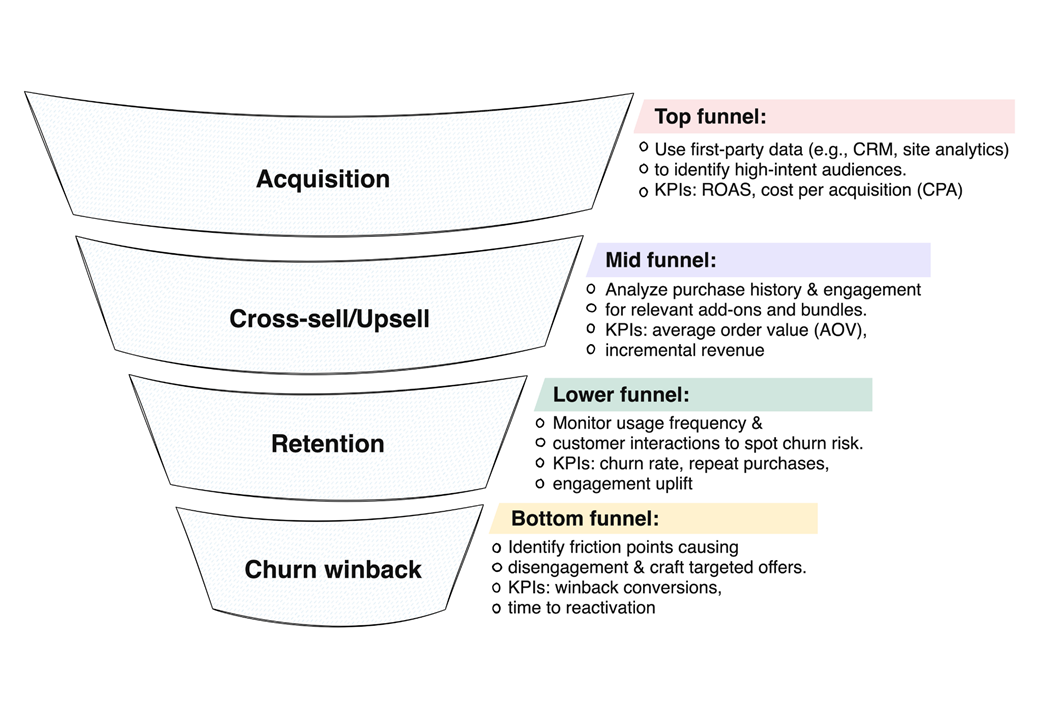1 First-party data in the digital marketing space
In a crowded and fast-changing marketing-tech landscape, the chapter makes the case that first-party data—collected directly through owned channels with clear consent—is the most durable, ethical foundation for growth. It argues that consumer expectations, evolving privacy regulations, and the fragmentation of third-party tracking have shifted power to customers, making transparency and trust non-negotiable. By centering strategy on first-party insights, marketers can deliver more relevant experiences, measure impact with confidence, and stay compliant while reducing reliance on volatile external signals.
The chapter positions first-party data within a broader ecosystem: zero-party data (explicitly shared preferences), first-party data (observed behaviors and attributes), second-party data (trusted partner exchanges), and third-party data (brokered aggregates with declining precision and transparency). First-party data should lead, with zero-party insights enriching intent, second-party collaborations extending reach under strict governance, and third-party inputs used sparingly for limited context. It then shows how first-party data powers personalization and loyalty across channels through six complementary dimensions—behavioral, psychographic, transactional, engagement, contextual, and technographic—creating a holistic view that drives meaningful, customer-centric experiences.
Addressing execution, the chapter highlights challenges such as data fragmentation across tools and clouds, identity resolution, and governance—advocating privacy-by-design, consent management, fine-grained access controls, and modern architectures like data lakehouses to unify diverse streams. It urges progress over perfection: prioritize high-impact use cases, test incrementality, and track clear KPIs to tie efforts to measurable outcomes across acquisition, cross-sell and upsell, retention, and churn winback. Finally, it underscores how machine learning and generative AI amplify first-party strategies—enabling prediction and scaled personalization—when fueled by clean, consented data, ensuring performance gains without compromising authenticity or trust.
Types of data

Overview of first-party data

User navigates to a website

Funnel stages of first-party data-driven marketing

Summary
- First-party data provides accurate insights into customer behaviors directly from brand interactions.
- Stricter privacy laws and the decline of third-party cookies push marketers to prioritize first-party data.
- Managing first-party data involves challenges like data quality, tech complexity, and privacy regulations.
- The data lakehouse combines scalability and management features to handle diverse data efficiently.
- A privacy-centric approach ensures compliance and builds customer trust through transparency and consent.
- The loss of third-party cookies reduces targeting accuracy, requiring new marketing strategies.
- First-party data enhances marketing across the customer journey, from acquisition to retention.
- Generative AI and machine learning personalize marketing by combining data insights with creative automation.
- Adopting a growth mindset focuses on leveraging available first-party data for sustainable business growth.
FAQ
What is first-party (1P) data?
First-party data is information your organization collects directly through channels you own—such as your website, app, stores, or CRM. It includes behaviors (pages viewed, purchases), attributes (account details, demographics), and engagement (email interactions, loyalty activity). Collected transparently with consent, it’s privacy-friendly, accurate, and fully controlled by your brand—forming the foundation of trustworthy, high-impact marketing.
How does first-party data differ from zero-, second-, and third-party data?
- Zero-party (0P): Customers proactively share preferences and intentions (surveys, wishlists). High consent, but may differ from actual behavior.
- First-party (1P): Observed directly from your owned touchpoints (transactions, web/app analytics). Most accurate and controllable.
- Second-party (2P): Another brand’s 1P data shared via partnerships. Extends reach, requires legal/privacy safeguards.
- Third-party (3P): Aggregated by brokers (e.g., cookie-based tracking). Broad scale but declining accuracy, transparency, and availability.
Why does first-party data matter more now?
Consumer expectations and privacy regulations have shifted power to customers. With third-party cookies restricted (blocked by default in Safari/Firefox and opt-in–based in Chrome), third-party data is fragmenting and less reliable. Brands need transparent, consented, high-quality data—making first-party data essential for personalization, measurement, and long-term trust.
What are the main benefits of using first-party data in marketing?
- Accuracy and relevance for personalization across channels.
- Stronger trust and compliance (GDPR, CCPA) through transparent collection.
- Better retention and higher customer lifetime value via lifecycle insights.
- Improved performance measurement and optimization grounded in real behaviors.
What challenges do organizations face when activating first-party data?
- Fragmentation across tools (CRM, POS, web/app analytics, loyalty) and clouds.
- Identity resolution and governance to create a unified customer view.
- Privacy-by-design requirements (purpose-based consent, access controls, deletion requests).
- Operationalizing insights in near real time across teams and systems.
What are the “faces” (core dimensions) of first-party data?
- Behavioral: Clicks, paths, session depth—find friction and optimize UX.
- Psychographic: Values, motivations—craft resonant storytelling and offers.
- Transactional: Purchases, frequency, channels—fuel upsell, cross-sell, CLV.
- Engagement: Email, social, visits—guide content and cadence.
- Contextual: Time, device, location—deliver timely, relevant experiences.
- Technographic: Devices, browsers, OS—optimize performance and UI by platform.
How should brands combine zero-party and first-party data?
Blend what customers say (0P intent and preferences) with what they do (1P behaviors). Use 0P to enrich profiles and guide hypotheses, and validate with 1P to avoid preference–behavior gaps. Earn data through transparency and clear value exchange (exclusive content, early access, loyalty rewards).
What is second-party data and how can we use it responsibly?
Second-party data is a trusted partner’s first-party data, shared under explicit agreements. Ensure aligned audiences and values, define purposes and rights in contracts, and use privacy-safe tech like data clean rooms. Watch for pitfalls: data quality mismatches, overreliance on one partner, and compliance gaps.
What are the limitations and risks of third-party data today?
- Declining availability and accuracy due to cookie restrictions and device sharing.
- Transparency and consent concerns, with growing regulatory scrutiny.
- Weak identity resolution leading to mistargeting and wasted spend.
- Best used for broad context or initial hypotheses—validate with 1P data.
How do AI/ML and modern data architectures enhance first-party data strategies?
Modern architectures (e.g., data lakehouses and cross-cloud querying) help unify diverse datasets for a single, governed view. Machine learning predicts churn, next best action, and high-value segments; generative AI scales personalized content. Ground models in privacy-compliant, well-governed 1P data and validate impact with incrementality testing and clear KPIs.
 First-Party Data Activation ebook for free
First-Party Data Activation ebook for free